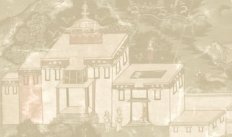
The Horkhang family traces its lineage to a Hor Karpo (Tsagaan Mongol, meaning "white Mongol"), the eldest son of a Oirat Taiji ("Mongol chief") in around Barta near Tibet's northern region. The chief had fled China and settled in Inner Mongolia following the fall of the Yuan Empire in 1368. When the Fifth Dalai Lama assumed leadership over Tibet, the descendants of Hor Karpo arrived in Lhasa with other local chieftains to felicitate the Dalai Lama. In Lhasa, they built a house known as Hor Khangsar, meaning the "new Mongol house." The family received an estate house with around twenty tenants or peasant families from the Fifth Dalai Lama. The possession of estates helped the family present itself as a Ger (sger, loosely equivalent to a baron or tenant-in-chief). Despite the honor received, the actual Tibetan ennoblement as kutrak (sku drag, aristocrat) came through intermarriage. When the family bore no sons in the early eighteenth century, it brought in three younger brothers of Polhane Sonam Tobgye as grooms, which not only elevated their standing in Lhasa but also tipped the family more towards a Tibetan ethnic identity. The Horkhang manor gradually began to enroll its members in the Tibetan Ganden Podrang government, with some holding the high title of jasagh, a ranked nobleman in the Manchu imperial system.